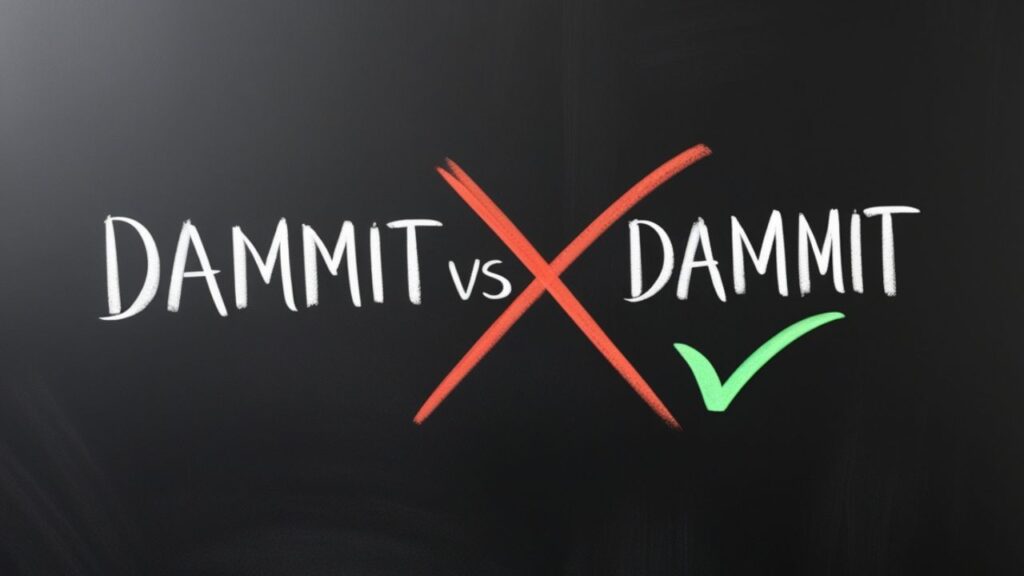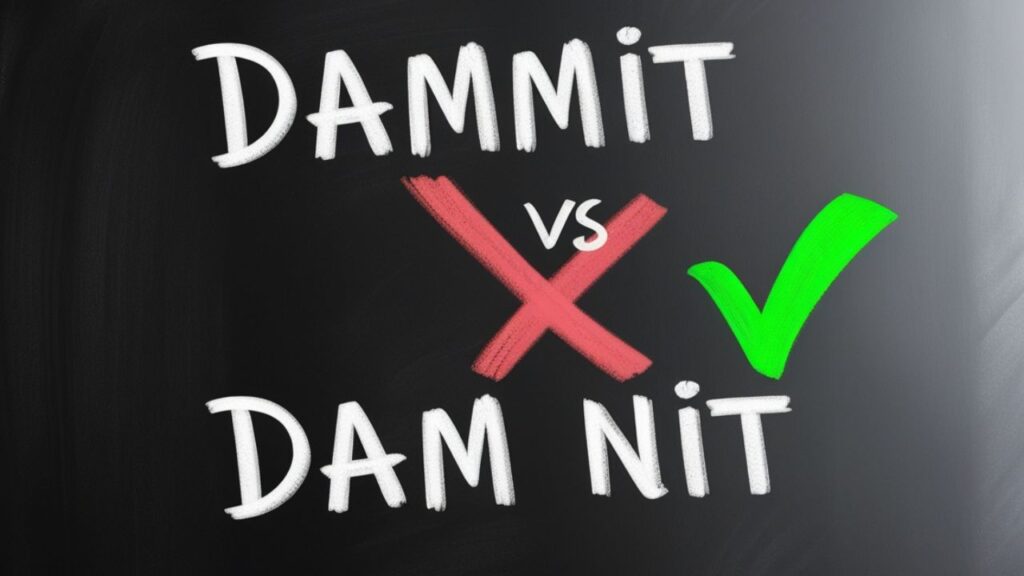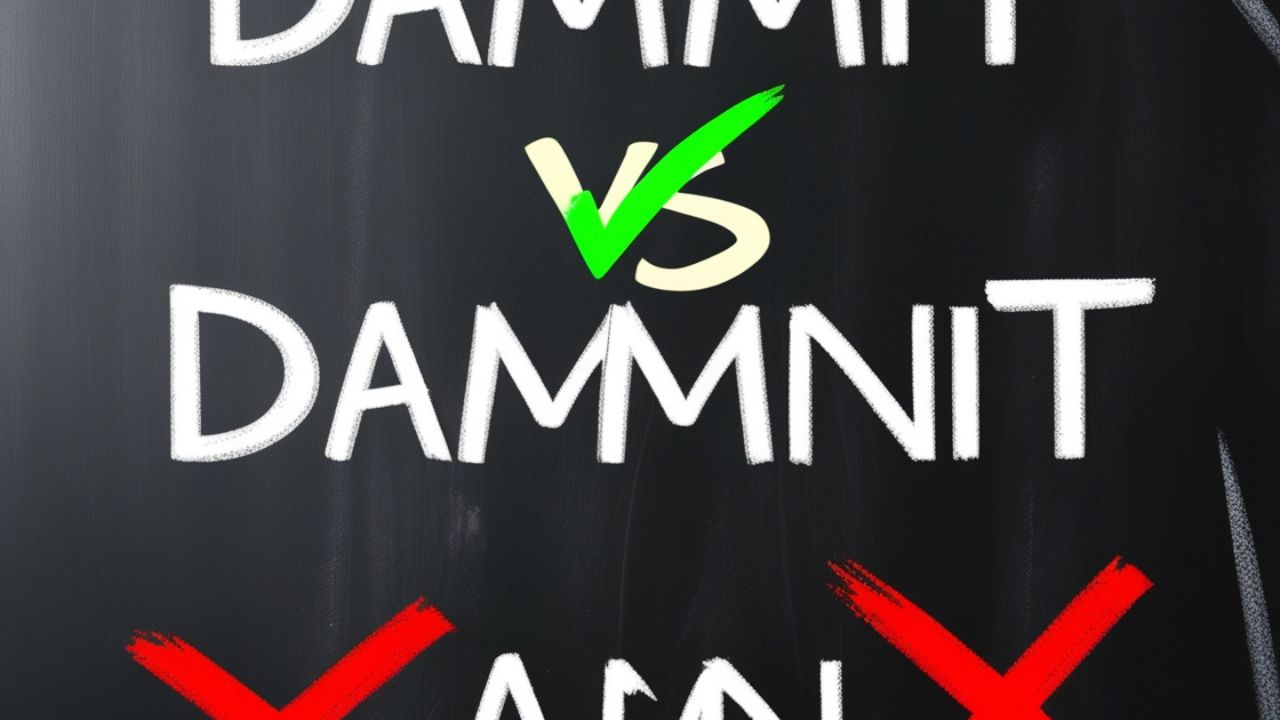Writers often feel unsure when they see dammit spelled in different ways. Dictionaries list only this version as correct. The form gives a strong sound and shows quick emotion. It looks natural in stories, conversations, and even in casual notes.
Another common form is damn it, which appears with a space. This version feels clearer and slightly formal. It works in serious writing or when someone wants to show frustration politely. Both versions share the same meaning but differ in tone.
The spelling damnit looks similar but is not standard. It often appears by mistake or through mishearing. Readers may see it as careless. For clear and proper expression, choosing dammit or damn it helps your writing stay correct and polished.
Etymology and Historical Origins
Where “Damn” Comes From
The word damn began in old Latin as damnare, which meant to punish or condemn. Later, French and English speakers used it in serious church writings. Over time, its meaning slowly softened, moving from heavy judgment to everyday speech that showed strong feelings.
By the 1500s, damn often appeared in angry expressions like “damn you.” In the 1800s, people started to treat it more like casual slang. What once carried fear of eternal punishment eventually turned into a common word that showed frustration or irritation in daily conversations.
The Evolution into “Dammit” and “Damnit”
Spoken language often changes over time. The phrase damn it slowly joined into one shorter word, creating dammit. People spoke quickly, leaving no pause. Writers began to copy this sound in books, newspapers, and dialogue, making it a common and accepted spelling.
Sometimes another form, damnit, appeared in writing. It came mostly from mistakes or from people spelling by sound. Unlike dammit, this version never gained wide approval. Dictionaries ignored it, so today it is seen as a nonstandard or careless choice.
Spelling Variants: Dammit vs. Damnit vs. Damn It
Official Dictionary Entries
| Dictionary | Entry | Notes |
| Merriam‑Webster | dammit | “used to express anger or frustration” |
| Oxford English | dammit | Classified as informal profanity |
| Cambridge Dictionary | dammit | Notes it as exclamation |
| Collins | dammit | Most common form |
Phonetic Simplification and Spelling Drift
People often speak faster than they write. In quick speech, the sound of damn it becomes shorter. The middle letter seems to disappear, and the word turns into dammit. This process shows how sounds can guide written forms.
Language naturally changes with time. When people hear a word in a clipped way, they sometimes copy that sound in writing. This creates new spellings. Over many years, spoken habits slowly shape what readers see in books or articles.
Linguistic Mechanics: Why “Dammit” Works
Phonology of Swearing
The phonology of swearing shows how sound gives power to words. Strong stress, sharp vowels, or clipped endings make expressions feel more intense. These sounds hit the ear quickly, which helps people release frustration or anger with greater effect.
Short and punchy forms often carry the most force. A word that ends suddenly feels stronger than a longer phrase. This is why certain exclamations spread widely in stories, conversations, and media, giving them lasting space in everyday language.
Morphological Compression
The idea of morphological compression explains how two words often combine into one. People shorten speech to save time and energy. Common blends like gonna or wanna show how everyday talking changes the shapes of words for easier use.
Writers notice that shorter forms carry quick rhythm and impact. When sounds merge, the result feels natural to the ear. This process is part of normal language growth, where simpler patterns slowly replace longer versions in both spoken and written expression.
See also : How Many Teaspoons in a Tablespoon? Easy Conversion Guide
Sociolinguistic Layers of Swearing
How Language Reflects Social Norms
The way people speak shows how society works. Language reflects social norms by marking what is polite, casual, or rude. Words that were once shocking may later feel normal as communities change and accept new ways of expression.
Cultural values shape which words seem strong or mild. Everyday talk in families, schools, or workplaces shows these rules clearly. Over time, traditions and attitudes guide how words are used, turning language into a mirror of social behavior.
Swearing Across Cultures
- When a small mistake happens, like missing the bus.
- While joking with friends to show playful frustration.
- In writing to give characters realistic emotion.
- On social media for short, expressive reactions.
- During casual talks to highlight sudden annoyance.
Contextual Usage: Dammit in the Real World

When to Use “Dammit” and Why
Writers often use dammit to show quick feelings like annoyance or surprise. It works well in stories, plays, and casual notes. The short form sounds natural in conversations, making dialogue stronger and closer to the way people really speak.
This spelling also gives a fast rhythm that matches sudden emotions. Readers can sense frustration right away without extra words. In creative writing or informal talk, choosing this form helps deliver impact while keeping the tone mild and expressive.
“Dammit” vs. “Damn It” vs. “Damnit” in Sentences
| Version | Sentence Example |
| dammit | “Dammit, I forgot my keys again.” |
| damn it | “Damn it, I forgot my keys again.” (slightly formal) |
| damnit | “Damnit, I forgot my keys again.” (misspelling likely) |
Literature, Media, and Pop Culture
“Dammit” in Classic and Modern Texts
Writers often placed dammit in classic novels to make dialogue sound real. Authors used it to show quick anger or frustration in characters. The word added emotion and helped readers connect with the feelings expressed in the story.
Modern books, songs, and shows also use this spelling for the same reason. It appears in scripts, music lyrics, and casual scenes. Its presence gives energy, rhythm, and realism, keeping characters believable and close to everyday speech.
Pop Culture’s Role in Normalizing the Word
- When you spill a drink or drop food by accident.
- After forgetting something important like keys or homework.
- In stories to show a character’s sudden frustration.
- On social media to add humor or quick emotion.
- During casual chats when expressing mild irritation.
Grammar and Usage: Swearing with Precision
Is “Dammit” a Real Word?
Yes, dammit is accepted as a real word. Dictionaries list it as an informal exclamation that shows annoyance or anger. Even though it feels casual, it has an official place in English and carries a clear meaning.
Writers often choose this spelling in dialogue because it looks natural and quick. Readers understand the emotion instantly. While it may not suit formal writing, it remains a recognized part of language that adds life, rhythm, and honesty to expression.
Should You Ever Use “Damn It” Instead?
Writers may pick damn it when they need clarity or a formal tone. The two-word form looks correct in serious settings like books, speeches, or structured writing. It separates the parts and gives stronger emphasis when frustration must sound clear.
This version also allows other words to fit in the middle, such as “damn it all.” That flexibility makes it useful in dramatic or emotional lines. While less sharp than the shorter form, it still communicates strong feeling effectively.
The Case Against “Damnit”
Why “Damnit” Isn’t Correct
| Term | Dictionary Accepted? | Common Usage | Notes |
| dammit |  Yes Yes |  Very common Very common | Correct informal form |
| damn it |  Yes Yes |  Common Common | Formal, clear, two words |
| damnit |  No No |  Rare Rare | Nonstandard / error |
Case Study: Dammit in Pop Music, Film, and TV
Let’s look at real-life usage examples that shaped public perception of dammit.
Blink-182’s “Dammit” (1997)
The song Dammit by Blink-182 came out in 1997. It quickly became popular because the music captured teenage struggles and change. The title word matched the emotions of frustration and growth, making the track powerful for young listeners at that time.
This single also helped the band gain fame worldwide. Fans connected with its honest tone and catchy rhythm. Even today, the song remains a classic example of how music and language join together to show real feelings in culture.
TV Series Usage
| Show | Usage Frequency | Tone | Notes |
| The Simpsons | High | Comedic | Bart uses “dammit” casually |
| Breaking Bad | Medium | Serious | “Damn it” used in emotional scenes |
| Friends | Low | Light | Rare use, mostly “crap” or “oh God” instead |
Swearing with Style: When to Use “Dammit”

Writers often use dammit to give scenes energy and emotion. It fits when a character feels annoyed, surprised, or upset. The short form carries rhythm and strength, making dialogue more real and adding force without sounding overly harsh or offensive.
This spelling also works well in casual notes, messages, or creative pieces. It shows quick reaction and helps capture frustration in just one word. Used carefully, it becomes a tool that adds personality and style to everyday writing.
See also : Of Course or Ofcourse: Correct Spelling and Usage Guide
Best Situations to Use “Dammit”
- When showing quick frustration after a small mistake, like dropping something.
- In casual conversations to add energy and emotion to speech.
- While writing character dialogue to make it sound real and natural.
- On social media posts for humor or light irritation.
- In creative stories where strong feelings need short, sharp words.
Avoid in:
- Formal business emails
- Academic papers
- Legal writing
Dammit in Online Communication
How It Shows Up in Texts and Social Media
In online spaces, dammit often appears in short posts, chats, and memes. People use it to show quick feelings like irritation or surprise. Its simple form matches the fast pace of digital talk, making emotions clear with very few words.
Social platforms highlight the word in captions, comments, and replies. It adds humor or intensity without sounding too strong. Writers on Twitter, Reddit, or Instagram often choose it because it feels natural, relatable, and easy to connect with audiences.
Digital Trends: Dammit’s Google Search Popularity
Search Volume & Regional Trends
| Search Term | Avg. Monthly Volume (US) | Global Volume | Trend Direction |
| dammit | 9,900 | 20,000+ |  Increasing Increasing |
| damn it | 4,400 | 10,000 |  Decreasing Decreasing |
| damnit | 1,300 | 2,500 |  Flat / Low Flat / Low |
Comparing Swear Words: Dammit and Its Peers
Where Does “Dammit” Rank in Mild Swearing?
| Swear Word | Intensity Level | Acceptability (Media) | Context |
| Dammit | Low |  Often allowed Often allowed | Frustration, exasperation |
| Crap | Low |  Common Common | Disappointment, messiness |
| Hell | Medium |  Sometimes censored Sometimes censored | Strong emotion, location |
| Shit | High |  Often censored Often censored | Anger, shock |
| Fuck | Very High |  Strictly censored Strictly censored | Extreme emotion, vulgarity |
Quotes from Writers and Linguists
Many experts share thoughts on swearing and its role in language. Writers and linguists explain that strong words can shape emotion and rhythm. Their studies show how even simple exclamations reveal culture, personality, and the way people express daily struggles.
Some scholars highlight how mild expletives reflect social change. Writers and linguists note that expressions once feared may soften with time. Their insights remind readers that language always moves forward, adapting to feelings, settings, and the voices of different generations.
Summary: Dammit vs. Damnit vs. Damn It
| Spelling | Accepted? | Best Use | Notes |
| Dammit |  Yes Yes | Informal writing, dialogue | Common, dictionary-approved |
| Damn it |  Yes Yes | Clear, formal emphasis | Use when clarity matters |
| Damnit |  No No | Never (or stylistic typo) | Not standard, avoid |
Conclusion
The spelling dammit has become the standard form for quick and expressive writing. It reflects real speech and carries emotion with strength. Writers choose it to give dialogue life, rhythm, and honesty without losing the meaning of the original phrase.
The two-word version damn it still holds value in formal or clear settings. It allows flexibility in structure and offers a softer yet precise expression. Both forms serve different purposes, showing how language adapts to tone and context.
The version damnit is not widely accepted. It often appears as a mistake and does not have dictionary approval. Using the correct spellings ensures clarity, professionalism, and style, helping communication remain both accurate and effective across many situations.
FAQs
Is it God dammit or God damnit?
The correct form is God dammit, as it matches natural speech. The version “God damnit” is considered a misspelling and not standard English.
Why not damnit?
Damnit is not accepted in standard English. Dictionaries list dammit as the proper spelling, while “damnit” often appears as a mistake in writing.
What is damnit?
Damnit is an incorrect spelling of dammit. It shows up online or in casual writing but is not recognized as the correct form in English.
What does Damnit mean in slang?
In slang, damnit expresses sudden anger, frustration, or annoyance. People use it quickly in speech or writing when reacting to mistakes, delays, or problems.

Join Bibcia on a journey to master English grammar. Discover easy lessons, writing tips, and practical examples designed to make learning grammar simple and effective.










